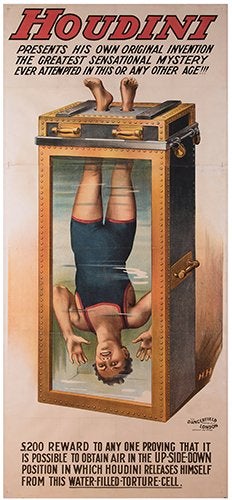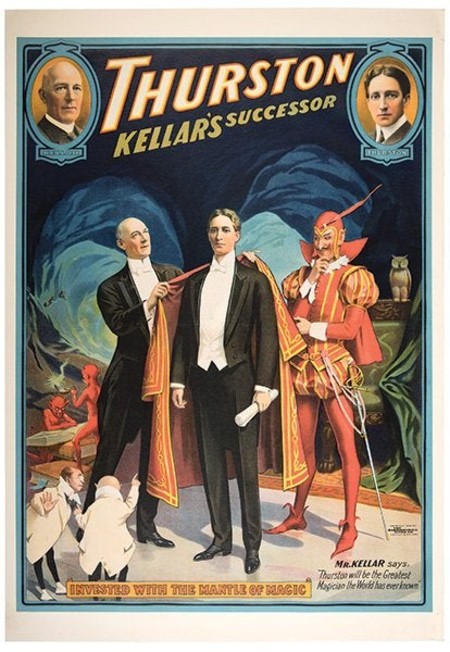
NEW YORK – An object tells a story but magic posters have myriad stories to tell. From picturing up-and-coming or celebrated magicians, these posters also tell a bit about society at the time they were made. Posters were created to be eye-catching and entice audiences to experience some of the mystery of magic by attending a performance. Vivid bold colors and language were largely employed while the occasional striking black and white posters also ably did the trick.
Looking back through the lens of time, posters are now appreciated and studied for also highlighting trends such as spiritualism, which became popular in the mid-19th century. Some examples also were guilty of the now-disdained techniques of cultural appropriation and caricaturing of Far East culture.
“Fueled in part by the advent of railroads and steamships, which opened up new lands to Western travelers, Americans and Europeans of the 19th century developed a fervent fascination with the Middle East, North Africa and Asia – a fascination that in turn inspired exoticized representations of the East in art, literature and even interior decorating trends,” according to a March 2020 article in Smithsonian Magazine.
“The appeal of magic posters is that there is usually the demonstration of something mysterious and you are drawn into that mystery by the artwork or sometimes by the language. Generally, it’s the artwork that pulls you in and it shows you another world – a more glamorous world, a world that is more mysterious,” said Charles Greene III, a corporate magician in the Washington, D.C., area, and owner of the website, MagicPosterGallery.com.

The golden age of magic (and magic posters) was 1890-1930 and well known for its amazing artwork and printing. Earlier Art Nouveau examples in the Jules Cheret and Toulouse-Lautrec era were almost tame by comparison. “Then you get into things with much brighter colors and blending of colors with much more technique that gives you posters that really do pop when you see them,” he said of golden age posters.
Collectors will seek out different attributes when collecting magic posters. Some look for who the magician is shown while others are interested in a particular illusion or magic trick. Legendary magician Harry Houdini is known to many, even those who are not big fans of magic. Other magicians whose posters are also desirable include Harry Kellar, Harry Blackstone Jr. and Sr., Howard Thurston, Charles Joseph Carter aka Carter the Great, and Chung Ling Soo.

In establishing value, Gabe Fajuri, co-founder of Potter & Potter Auctions in Chicago, said there are a number of factors at play: rarity, subject matter and the aesthetic qualities of the image. “Carter posters, for example, are not rare, at least the ones that Otis printed for him are not all that rare – other earlier examples for him do qualify as rare, but they are valuable based on the aesthetic qualities of each image,” he said.
“Houdini is at the top of the heap in terms of value and collectibility,” Fajuri added. “His images always fetch high prices, even if they are not visually stunning, due to the fact that he is the most famous magician of all time.”
Houdini magic posters are highly sought after but early-on as a film star, Houdini also commissioned posters for his films. “Both are highly desirable for different reasons,” Greene said. “There is another genre of people who really know magic history that go for a whole different line of posters that may feature a trick or particular performer.”

Greene is a devotee of posters featuring magician Clementine de Vere, whose stage name was Ionia. Of the approximately 22 known posters of her, he says about a dozen examples have been found and they do well at auction. “They are beautiful, the female magician doing very magical things. Some are just portraits of her hands and face and some are full-on illusion scenes,” he said. Her life story is also compelling. Born in Brussels into a family of entertainers, she traveled all over working as a magician and married first a lion tamer, then a prince.
Others prefer posters that also picture the audience’s reaction as a trick is being down. “It’s the magician and the audience and you see the realization of magic and what it’s all about,” he said.
From collectors to museums, magic posters are a popular genre. The Art Gallery of Ontario mounted an exhibition in 2020 titled “Illusions: The Art of Magic,” which featured several striking posters back when magicians had to be showmen and use attractive posters to market themselves. The exhibition featured 55 posters from the Allan Slaight Collection of the McCord Museum, Montreal.

“These posters tell us so much about that time – the public’s fascination with Asia, with spiritualism, the occult and the changing role of women in society,” stated Julian Cox, the AGO’s deputy director and chief curator in a press release.
The American Museum of Magic in Marshall, Mich., also has a fine collection of magic posters, including “Mildred and Rouclere: Flight of Princess Iris,” 1897, featuring the husband-wife magician act, and the black-and-white “Ankele’s Wonders” poster depicting Robert Ankeles in various scenes. Despite only being in black and white, the poster packs a punch showing different vignettes and anti-spiritualist tricks that were common then. Another striking poster here is a 1905 one depicting Harry Kellar, “Kellar: The Witch, the Sailor and the Enchanted.”
“Magic posters are everywhere and just at the moment I think that something has never been seen or that here’s only one of something, something new pops up,” Greene said, adding that there are always surprises and an unknown great poster could be hiding in an old theater or under someone’s bed.



